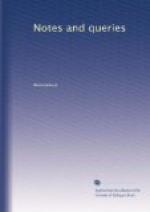“London Bridge is broken down;
Gold is won and bright renown;
Shields resounding,
War horns sounding,
Hildur shouting in the din;
Arrows singing,
Mail-coats ringing,
Odin makes our Olaf win.”
See Laing’s Heimskringla, vol. ii. p. 10.; and Bulwer’s Harold, vol. i. p. 59. The last-named work contains, in the notes, some excellent remarks upon the poetry of the Danes, and its great influence upon our early national muse.
EDWARD F. RIMBAULT.
[T.S.D.’s inquiry respecting this once popular nursery song has brought us a host of communications; but none which contain the precise information upon the subject which is to be found in DR. RIMBAULT’s reply. TOBY, who kindly forwards the air to which it was sung, speaks of it as a “‘lullaby song,’ well-known in the southern part of Kent and in Lincolnshire.”
E.N.W. says it is printed in the collection of Nursery Rhymes published by Burns, and that he was born and bred in London, and that it was one of the nursery songs he was amused with. NOCAB ET AMICUS, two old fellows of the Society of Antiquaries, do not doubt that it refers to some event preserved in history, especially, they add, as we have a faint recollection “of a note, touching such an event, in an almost used-up English history, which was read in our nursery by an elder brother, something less than three-fourths of a century since. And we have also a shrewd suspicion that the sequel of the song has reference to the reconstruction of that fabric at a later date.”
J.S.C. has sent us a copy of the song; and we are indebted for another copy to AN ENGLISH MOTHER, who has accompanied it with notices of some other popular songs, notices which at some future opportunity we shall lay before our readers.—ED.]
* * * * *
ARABIC NUMERALS.
(Vol. ii., pp. 27. 61.)
I must apologise for adding anything to the already abundant articles which have from time to time appeared in “NOTES AND QUERIES” on this interesting subject; I shall therefore confine myself to a few brief remarks on the form of each character, and, if possible, to show from what alphabets they are derived:—
1. This most natural form of the first numeral is the first character in the Indian, Arabic, Syriac, and Roman systems.
2. This appears to be formed from the Hebrew [Hebrew: b], which, in the Syriac, assumes nearly the form of our 2; the Indian character is identical, but arranged vertically instead of horizontally.
3. This is clearly derived from the Indian and Arabic forms, the position being altered, and the vertical stroke omitted.
4. This character is found as the fourth letter in the Phoenician and ancient Hebrew alphabets: the Indian is not very dissimilar.
5. and 6. These bear a great resemblance to the Syriac Heth and Vau (a hook). When erected, the Estrangelo-Syriac Vau is precisely the form of our 6.




